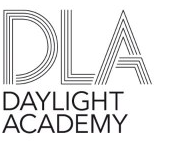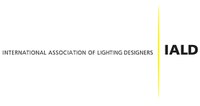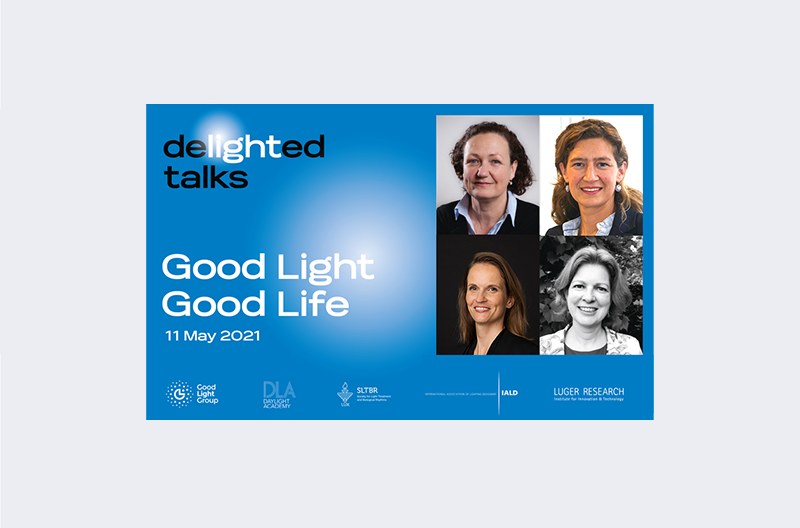deLIGHTed Talks: Good Light – Good Life | May 11th, 3 PM CEST
The Good Light Group, together with the Society for Light Treatment and Biological Rhythms (SLTBR), the Daylight Academy (DLA), the International Association of Lighting Designers (IALD), and Luger Research (LR), are organizing and presenting the “Good Light – Good Life” lectures. The webinar explains how good light indoors contributes to health and well-being.
This webinar will take place as part of UNESCO’s International Day of Light 2021 event.

Date/Time/Registration
Date/Time: May 11th , 2021 from 03:00 PM - 04:30 PM (CEST)
Registration: Free of charge http://bit.ly/2POUELF
Lectures
Relevance of Daylight for Humans | DLA
by Mirjam MÜNCH, Dr.
Centre for Public Health Research, Massey University Wellington, New Zealand
The Healing Effect of Light Therapy Combined with Lifestyle Advices in Affective Disorders | SLTBR
by Lisette ROPS, Psychiatrist at GGze, The Netherlands
Case Study of a School Project | IALD
by Julia HARTMANN, Dipl.-Ing.(FH) Interior Design, IALD, CLD
CEO and Creative Director at lightsphere, Switzerland
Good Light for Healthy, Daytime-active People | GLG
by Annette STEINBUSCH, MSc.
S&R Manager Light Quality at Signify, The Netherlands

Mirjam Münch, PhD Dr Münch has substantial expertise in sleep and chronobiology and the impact of light on humans. After her PhD thesis at the Centre for Chronobiology in Basel (Switzerland), she worked as post-doctoral Research Fellow at Harvard Medical School (Boston, USA) and at the Swiss Federal Institute of Technology in Lausanne (Switzerland). In 2015, she completed her Habilitation (privat docent) at Charité University Medicine in Berlin (Germany), where she worked for five years. Most recently, Dr Münch spent over two years at Massey University in Wellington (New Zealand) as Associate Professor and portfolio Director of Circadian Health Research. She returned to Switzerland in January 2021. Dr Münch has a strong publication record, received several awards and is a founding member of the Daylight Academy.
Dr Münch has substantial expertise in sleep and chronobiology and the impact of light on humans. After her PhD thesis at the Centre for Chronobiology in Basel (Switzerland), she worked as post-doctoral Research Fellow at Harvard Medical School (Boston, USA) and at the Swiss Federal Institute of Technology in Lausanne (Switzerland). In 2015, she completed her Habilitation (privat docent) at Charité University Medicine in Berlin (Germany), where she worked for five years. Most recently, Dr Münch spent over two years at Massey University in Wellington (New Zealand) as Associate Professor and portfolio Director of Circadian Health Research. She returned to Switzerland in January 2021. Dr Münch has a strong publication record, received several awards and is a founding member of the Daylight Academy.
Relevance of daylight for humans (DLA)
Sunlight is a prerequisite for life on earth and crucial for health and wellbeing in humans. A variety of physiological and psychological functions are modulated by perception through light sensitive photoreceptors in the eye, and by sunlight perception via skin (e.g. for Vitamin D production). Exposure to short-wavelength electric light before bedtime can disrupt circadian clock functions and challenge sleep quality. Newer evidence suggests that such negative light effects are magnified by low intensity light exposure during the day, especially during the first half of the waking period. In recent years, some efforts have been made to better understand and to mitigate circadian disruption in shift-workers and patient groups by different approaches including (day-)light interventions. There is, however, no consensus across disciplines how (day-)light exposure needs to be integrated in such an endeavour - spanning from architectural design solutions for homes and schools to clinical practice in institutions. This presentation will summarize some of the key factors and basic concepts on the impact of (day-)light on humans. It will also highlight general relevance and possibilities of better integration of (day-)light exposure under daily life conditions.

Lisette ROPS, Psychiatrist  Ms. ROPS is Psychiatrist at GGzE, Head of the department of Bipolar Disorder GGzE and Head of the department of Light and lifestyle treatment GGzE, Boardmember medical staff GGzE, Member of KENBIS, and member workgroup Chronotherapy for bipolar disorder. Further, Member of the Dutch Association Chrono Netwerk Nederland (CNN).
Ms. ROPS is Psychiatrist at GGzE, Head of the department of Bipolar Disorder GGzE and Head of the department of Light and lifestyle treatment GGzE, Boardmember medical staff GGzE, Member of KENBIS, and member workgroup Chronotherapy for bipolar disorder. Further, Member of the Dutch Association Chrono Netwerk Nederland (CNN).
The Healing Effect of Light Therapy Combined with Lifestyle Advices in Affective Disorders | SLTBR
During this presentation, you will hear about the healing effect of light within medicine. Light therapy and chronotherapy are a great added value in the treatment of physical and mental diseases. In 2017 the Nobel prize in medicine was for the research on the biological clock. Lisette ROPS will talk about research on light therapy for clients with bipolar disorder and how they have expanded this treatment from one ward to the whole institution. We integrated light therapy with lifestyle advice to maximize the effect of resetting the biological clock. We have finished a client satisfaction survey and research the effectiveness of this therapy on mood and sleep.

Julia HARTMANN, Dipl.-Ing.(FH) Julia Hartmann, CLD, IALD is the Principal and Creative
Julia Hartmann, CLD, IALD is the Principal and Creative
Director of lightsphere, an award winning and multi-disciplinary lighting design practice based in Zurich, Switzerland and Vaduz, Liechtenstein.
After graduating with a Diploma in Interior Design with honours from University of Applied Sciences Coburg, Germany, Julia started her career in Lighting Design 2007 in Switzerland working on various notable national and international projects before founding her own practice lightsphere in 2014. Julia is volunteering in a series of committees for the International Association of Lighting Designers (IALD) to help shape the future of the lighting design profession and also serves as one of the Alpine Regional Coordinators for IALD and was selected ambassador of Switzerland from Women In Lighting (WIL).
Case Study of a School Project | IALD
The project consists of an existing school complex expanded with a new school building and a dual gymnasium.
The school building defines itself as the „school living space“ - with classrooms, kindergarten and auditorium. All areas can be operated individually or jointly, connected by the central two-story school hall which can be used and furnished for educational purposes, as well as being the main circulation area. The main goal of the lighting design was creating an interplay of light and space where light fixtures are hardly visible or completely invisible. Furthermore, a detailed analysis of opening positions, selection of materials and their reflective performance was carried out, in cooperation with the architects, in order to achieve the optimal amount of daylight in all areas, equivalent to an average annual daylight quotient of 7.2% and 18.7% respectively for central hall and classrooms.
The supplementary artificial lighting is integrated into the architectural elements of the space, highlighting the concept idea to see the light effect but not the luminaires. The energy consumption of the school building is 3W/m2 and with the additional daylight sensors in all rooms energy rates can be cut another 35%. Due to budget constrains we selected a luminaires family of ceiling panels with different dimensions that could fit the acoustic ceiling panels, to reduce on site cutting. With the different sizes and arrangements of panels it was possible to diversify the areas, with a playful arrangement in the kindergarten and a clear rhythm in the primary school space. The lighting design of the gym intends to achieve a functional and vertical lighting able to create depth of space and easy orientation. The vertical lighting designed in the corridors and the transparency of the perimetral lamellas of the training area create an exciting interplay of light, colors and reflections. The presentation will share some project insights from daylighting design to the design integration of artificial light into the space.

Annette STEINBUSCH, MSc. Annette Steinbusch is Standards & Regulations manager at Signify, driving light quality topics and human centric lighting. She is also active in LightingEurope, the Global Lighting Association, the Good Light Group and board member of the International Commission on Illumination (CIE). Annette has over 25 years of experience in the areas of supply chain management, business improvement, sustainability and standards & regulations. She holds a Master’s degree in Industrial Engineering and Management Science from the Eindhoven University of Technology in The Netherlands.
Annette Steinbusch is Standards & Regulations manager at Signify, driving light quality topics and human centric lighting. She is also active in LightingEurope, the Global Lighting Association, the Good Light Group and board member of the International Commission on Illumination (CIE). Annette has over 25 years of experience in the areas of supply chain management, business improvement, sustainability and standards & regulations. She holds a Master’s degree in Industrial Engineering and Management Science from the Eindhoven University of Technology in The Netherlands.
Good Light for Healthy, Daytime-active People | GLG
People need daylight to synchronize their circadian clock, or indoor lighting that mimics the positive aspects of daylight. We call this good light. Good Light is Attractive: Good Light indoors is high quality and comfortable for the eyes. Good Light is Dynamic: Good Light indoors is stimulating during the day with an intensity that is at least 5x higher and relaxing during the evening with an intensity that is at least 5x lower, than the current standard for vision. Good Light is Optimized: Good Light indoors has spectral characteristics that vary according to time of day, personal needs, and specific tasks. Good Light is Personal: Good Light indoors can be adapted by the user for personal needs based on suggestions by the system. The Good Light Group has launched a lighting guide for healthy people with daytime activity. This presentation explains what to keep in mind to design Good Light.

___
© 2021 LED professional / Luger Research e.U.




